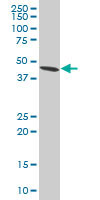ADRM1 Antibody (clone 3D11)
Mouse Monoclonal Antibody
- SPECIFICATION
- CITATIONS
- PROTOCOLS
- BACKGROUND

Application
| WB, IHC-P, E |
|---|---|
| Primary Accession | Q16186 |
| Reactivity | Human |
| Host | Mouse |
| Clonality | Monoclonal |
| Clone Names | 3D11 |
| Calculated MW | 42kDa |
| Dilution | IHC-P (10 µg/ml), WB (1:500-1:1000), |
| Gene ID | 11047 |
|---|---|
| Other Names | Proteasomal ubiquitin receptor ADRM1, 110 kDa cell membrane glycoprotein, Gp110, Adhesion-regulating molecule 1, ARM-1, Proteasome regulatory particle non-ATPase 13, hRpn13, Rpn13 homolog, ADRM1, GP110 |
| Target/Specificity | Human ADRM1 |
| Reconstitution & Storage | Store at -20°C or lower. Aliquot to avoid repeated freezing and thawing. |
| Precautions | ADRM1 Antibody (clone 3D11) is for research use only and not for use in diagnostic or therapeutic procedures. |
| Name | ADRM1 |
|---|---|
| Synonyms | GP110 |
| Function | Component of the 26S proteasome, a multiprotein complex involved in the ATP-dependent degradation of ubiquitinated proteins (PubMed:16815440, PubMed:16906146, PubMed:16990800, PubMed:17139257, PubMed:18497817, PubMed:24752541, PubMed:25702870, PubMed:25702872). This complex plays a key role in the maintenance of protein homeostasis by removing misfolded or damaged proteins, which could impair cellular functions, and by removing proteins whose functions are no longer required (PubMed:16815440, PubMed:16906146, PubMed:16990800, PubMed:17139257, PubMed:18497817, PubMed:24752541, PubMed:25702870, PubMed:25702872). Therefore, the proteasome participates in numerous cellular processes, including cell cycle progression, apoptosis, or DNA damage repair (PubMed:16815440, PubMed:16906146, PubMed:16990800, PubMed:17139257, PubMed:18497817, PubMed:24752541, PubMed:25702870, PubMed:25702872). Within the complex, functions as a proteasomal ubiquitin receptor (PubMed:18497817). Engages and activates 19S- associated deubiquitinases UCHL5 and PSMD14 during protein degradation (PubMed:16906146, PubMed:16990800, PubMed:17139257, PubMed:24752541). UCHL5 reversibly associate with the 19S regulatory particle whereas PSMD14 is an intrinsic subunit of the proteasome lid subcomplex (PubMed:16906146, PubMed:16990800, PubMed:17139257, PubMed:24752541). |
| Cellular Location | Cytoplasm. Nucleus |

Thousands of laboratories across the world have published research that depended on the performance of antibodies from Abcepta to advance their research. Check out links to articles that cite our products in major peer-reviewed journals, organized by research category.
info@abcepta.com, and receive a free "I Love Antibodies" mug.
Provided below are standard protocols that you may find useful for product applications.
Background
Functions as a proteasomal ubiquitin receptor. Recruits the deubiquitinating enzyme UCHL5 at the 26S proteasome and promotes its activity.
References
Shimada S.,et al.Cancer Res. 54:3831-3836(1994).
Hamazaki J.,et al.EMBO J. 25:4524-4536(2006).
Deloukas P.,et al.Nature 414:865-871(2001).
Qiu X.-B.,et al.EMBO J. 25:5742-5753(2006).
Joergensen J.P.,et al.J. Mol. Biol. 360:1043-1052(2006).
If you have used an Abcepta product and would like to share how it has performed, please click on the "Submit Review" button and provide the requested information. Our staff will examine and post your review and contact you if needed.
If you have any additional inquiries please email technical services at tech@abcepta.com.













 Foundational characteristics of cancer include proliferation, angiogenesis, migration, evasion of apoptosis, and cellular immortality. Find key markers for these cellular processes and antibodies to detect them.
Foundational characteristics of cancer include proliferation, angiogenesis, migration, evasion of apoptosis, and cellular immortality. Find key markers for these cellular processes and antibodies to detect them. The SUMOplot™ Analysis Program predicts and scores sumoylation sites in your protein. SUMOylation is a post-translational modification involved in various cellular processes, such as nuclear-cytosolic transport, transcriptional regulation, apoptosis, protein stability, response to stress, and progression through the cell cycle.
The SUMOplot™ Analysis Program predicts and scores sumoylation sites in your protein. SUMOylation is a post-translational modification involved in various cellular processes, such as nuclear-cytosolic transport, transcriptional regulation, apoptosis, protein stability, response to stress, and progression through the cell cycle. The Autophagy Receptor Motif Plotter predicts and scores autophagy receptor binding sites in your protein. Identifying proteins connected to this pathway is critical to understanding the role of autophagy in physiological as well as pathological processes such as development, differentiation, neurodegenerative diseases, stress, infection, and cancer.
The Autophagy Receptor Motif Plotter predicts and scores autophagy receptor binding sites in your protein. Identifying proteins connected to this pathway is critical to understanding the role of autophagy in physiological as well as pathological processes such as development, differentiation, neurodegenerative diseases, stress, infection, and cancer.



